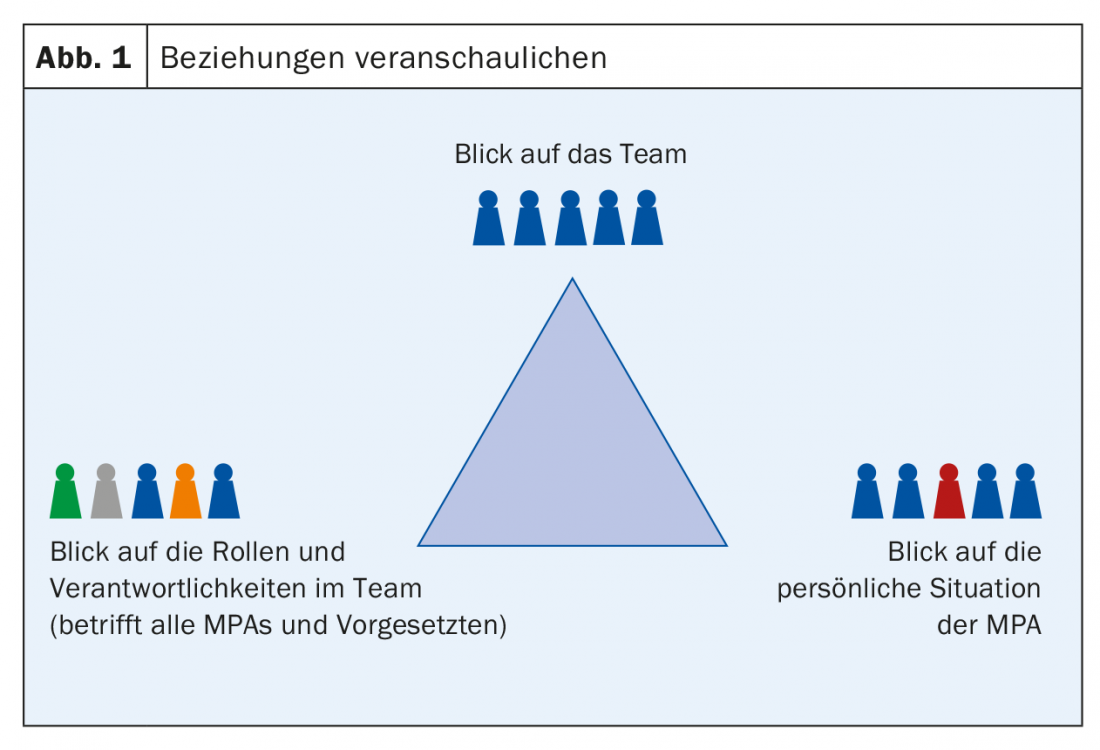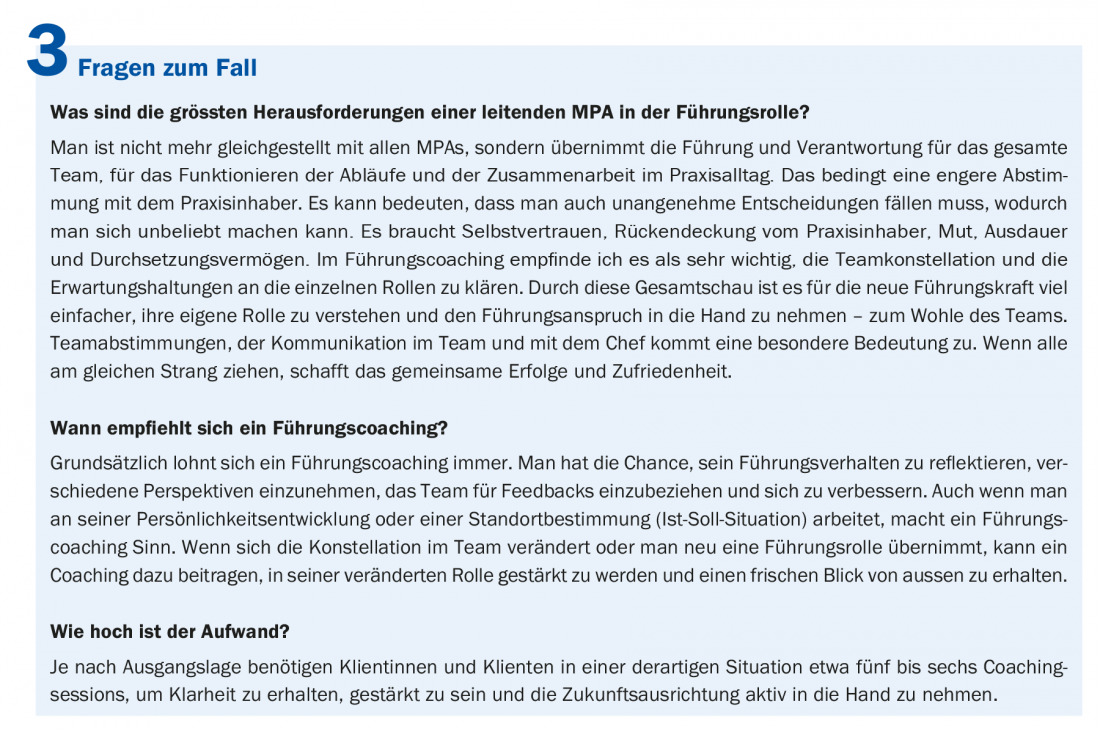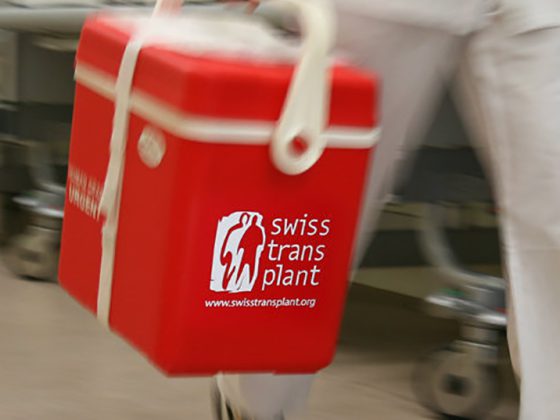In addition to caring for and triage patients, senior MPAs also perform management functions within the practice team. What does it take for this to work well and for the role changes to be constructive and beneficial? In a leadership coaching, topics like these can be reflected and worked on.
The case: an MPA was promoted to senior MPA by her supervisor. He had not chosen her without reason: She has been familiar with the day-to-day running of the practice for years, is friendly to patients, can set priorities, gets on very well with the team, is well respected and keeps a cool head in stressful situations. But as a former team member, the new role unsettles her. Therefore, she comes to leadership coaching with the following question in mind: “How can I perform the new role as a senior MPA in such a way that I lead and yet remain a recognized part of the team to achieve good results together?”
Initial analysis: promotion to senior MPA within the team raises several questions about leadership and communication:
- Leadership: Who are the team members? Who performs which role with which responsibilities? What’s going well, what needs improvement? How do I want to lead the team into the future? What do I need and what does the team need for this?
- Communication: How does communication work in the team and how can it be optimized? What is my contribution? What is the supervisor’s contribution? What is the contribution of the team?
Coaching approach: In leadership coaching, we first look at the situation in the team. Who are the team players? How are roles and responsibilities regulated? What are the group dynamics like? How are the power relations structured and how does the cooperation and communication work? With the help of a set of figures, the situation can be visualized schematically, which allows it to be viewed from different perspectives (Fig. 1).

First, we took a close look at the team. For this, we made a team constellation in which we positioned each team member with a figure and related them to each other. Through visualization, the lead MPA recognized the relationships within the team, recurring patterns (underlying conflicts) and relationship constellations (alliances) could be made transparent. Based on these findings, we developed strategies and measures to move from the ACTUAL situation to the desired TARGET situation. Furthermore, we focused on the strengths of each team member and worked out how the senior MPA could use these competencies in the team. On the one hand, she was able to promote development in a targeted manner, and on the other hand, she was able to increase her own motivation.
In a second step, I focused on the roles and responsibilities in the team, not only those of the lead MPA, but also those of the other MPAs as well as the supervisor. This is because a role is defined by the sum of all the expectations of the various stakeholders (MPAs, physicians, managers, patients, etc.). Central to this step were questions that could provide information about the expectations of the participants:
- What are the expectations of MPAs, physicians, patients, and other stakeholders for this role?
- Which of these expectations do I “want to meet,” “want to meet in part,” and “don’t want to meet”?
Through this lineup, the senior MPA became aware of the expectations of such a position – regardless of who holds it. This made her realize that it is unrealistic to live up to all expectations and that these different expectations can be the cause of conflicts.
We then looked at the two roles of “MPA” and “senior MPA”. This delineation is important because, depending on the size of the medical practice, the senior MPA also acts in day-to-day operations. A clear differentiation of roles is helpful for both the senior MPA and the team:
- When do I wear “the senior MPA’s hat,” when that of the MPA?
- How does this “hat change” manifest itself and where are there differences in terms of environment, behavior, skills and values?
Through the constellation, the lead MPA was able to gain clarity about her role design and that of the other team members. Through various role plays, she identified in which situations she wears which “hat.” This gave her confidence in her leadership role and as an extension of her supervisor.
Based on the descriptions, it seemed to me to make sense in a next step to take a look at the personal situation of the MPA. The MPA addressed the following questions to gain clarity on the new direction:
- What is important to me?
- Where do I see positive development opportunities? Where are there stumbling blocks?
- What can help me and the team develop strengths? What does that mean for collaboration?
- What are my strengths and weaknesses?
Results:
- The senior MPA originally came to leadership coaching with a personal, ME-related concern. She wanted to clarify for herself how she could competently lead the team and assert herself as a leader.
- By setting up the team situation and looking at it from different perspectives, the senior MPA gained an overarching view of her situation as a leader and was able to derive necessary conclusions for the roles and responsibilities in the team as well as for collaboration and communication.
- The expectations of their function have been clarified.
- She gained an awareness of the role differentiation between “MPA”, “senior MPA” and physician leadership with respect to the day-to-day practice.
- She realized what was important to her and how she made decisions. By coming to terms with her strengths and weaknesses, she was able to better differentiate herself and delegate certain tasks to team members. She also discovered her new leadership role as a learning field for personal development.
- Through leadership coaching, she gained more confidence and self-assurance regarding her role as a senior MPA as well as a team member.

Transfer to everyday practice: The clarification of expectations regarding the different roles proved to be particularly helpful. The MPA now knew the expectations for herself from different perspectives and could match them with her own expectations. This enabled it to position itself clearly and to communicate this. This made her day-to-day management and teamwork easier. For positioning, she clarified the practice owner’s expectations, among other things, which gave her backing and confidence. They now exchange information regularly in meetings, which had a positive impact on the flow of information and ensured a good basis of trust throughout the team. Since productive cooperation is important to the senior MPA, she incorporated the expectations, wishes and feedback from the team into her work, which also improved cooperation within the team as a whole.
Conclusion: Leadership is a task that should be viewed from a bird’s eye view and successfully managed. Focusing too much on a single personality and its own sensitivities does not lead to the goal.
HAUSARZT PRAXIS 2019; 14(1): 4-6











